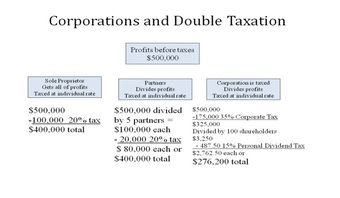6.1: Sole Proprietorships
6.1.1: A Brief Definition of Sole Proprietorships
A sole proprietorship is owned and run by one individual who receives all profits and has unlimited responsibility for all losses and debts.
Learning Objective
Define a sole proprietorship
Key Points
- In a sole proprietorship, there is no legal distinction between the individual and the business. Thus, every asset is owned by the proprietor, and they have unlimited liability.
- Examples include writers and consultants, local restaurants and shops, and home-based businesses.
- A sole proprietor may use a trade name or business name other than his or her legal name.
Key Term
- Sole Proprietorship
-
a business that is wholly owned by a single person, who has unlimited liability
Example
- An example of a sole proprietorship is an individual who runs a local food truck and would be listed as such with the city.
A sole proprietorship, also known as the sole trader or simply a proprietorship, is a type of business entity that is owned and run by one individual and in which there is no legal distinction between the owner and the business. Some formal definitions of a sole proprietorship are “a business owned by one person who is entitled to all of its profits” (Glos & Baker) and “a business owned and controlled by one man even though he may have many other persons working for him” (Reed & Conover).
The individual entrepreneur owns the business and is fully responsible for all its debts and legal liabilities. The owner receives all profits (subject to taxation specific to the business) and has unlimited responsibility for all losses and debts. Every asset of the business is owned by the proprietor, and all debts of the business are the proprietor’s. This means that the owner has no less liability than if they were acting as an individual instead of as a business. It is a “sole” proprietorship in contrast with partnerships. More than 75% of all United States businesses are sole proprietorships. Examples include writers and consultants, local restaurants and shops, and home-based businesses.

Mom and pop store
This is a small proprietor with a small shop.
A sole proprietor may use a trade name or business name other than his or her legal name. In many jurisdictions, there are rules to enable the true owner of a business name to be ascertained. In the United States, there is generally a requirement to file a doing business as statement with the local authorities. In the United Kingdom, the proprietor’s name must be displayed on business stationery, in business emails, and at business premises, and there are other requirements.
6.1.2: Advantages of Sole Proprietorships
The advantages of a sole proprietorship versus other forms of organizations is the relative ease of set-up and the lower start-up costs.
Learning Objective
Discuss the advantages of running a sole proprietorship
Key Points
- Filing taxes as a sole proprietorship is relatively easier than that of a corporation.
- Sole proprietorships typically require less capital to set up and have easier payroll requirements.
- Sole proprietorships are not as heavily regulated as other forms of organizations.
Key Term
- corporate
-
An incorporated entity is a separate legal entity that has been incorporated through a legislative or registration process established through legislation.
Example
- A man starting his own consulting firm as a sole proprietor would require very little capital to set up a home office to operate until sufficient funds are earned to open a larger office.
Advantages of Sole Proprietorship
The sole proprietor form of business ownership is the most common form in the United States and also the simplest. In this form of business ownership, an individual proprietor owns the business, manages the business, and is responsible for all of the business’ transactions and financial liabilities. This means that any debts incurred must be paid by the owner. This form of business has several advantages .

A Writer’s Office
A write enjoying the advantages of being a sole proprietor.
Quicker Tax Preparation
As a sole proprietor, filing your taxes is generally easier than a corporation. Simply file an individual income tax return (IRS Form 1040), including your business losses and profits. Your individual and business income are considered the same and self-employed tax implications will apply.
Lower Start-up Costs
Limited capital is a reality for many start-ups and small businesses. The costs of setting up and operating a corporation involves higher set-up fees and special forms. It’s also not uncommon for a lawyer to be involved in forming a corporation.
Ease of Money Handling
Handling money for the business is easier than other legal business structures. No payroll set-up is required to pay yourself. To make it even easier, set up a separate bank account to keep your business funds separate and avoid co-mingling personal and business activities.
Government Regulation
Sole proprietorships also have the least government rules and regulations affecting it. They do need to comply with licensing requirements within the states in which they do business and they do need to pay attention to local regulations. However, the paperwork required is much less than large corporations. Thus, they can operate quite easily. Sole proprietorships also do not pay corporate taxes.
Sale and Inheritance
The sole proprietor can own the business for as long as he or she decides, and can cash in and sell the business when they decide to get out. The sole proprietor can even pass the business down to their heir, a common practice.
6.1.3: Disadvantages of Sole Proprietorships
Sole proprietorships face a number of difficulties in the longer terms compared to limited liability companies.
Learning Objective
List the disadvantages of sole proprietorships
Key Points
- The owner of a sole proprietorship is solely liable for all debts and actions of the company. All personal wealth is linked to the business.
- Financial statements are not required in a sole proprietorship as are typically required of a corporation, meaning a lack of financial control is very probable.
- It is difficult to find outside investors to fund sole proprietorships, meaning growth potential is very limited beyond a certain point.
Key Term
- unlimited liability
-
The liability of an owner of a small proprietorship for all costs and debts of the business.
Example
- An individual who wishes to open a sandwich shop must put their own money into the business, knowing that, should it fail, they will be responsible for all costs and debts that will be incurred.
Sole proprietorships are the smallest form of business organization, and also the most common in the United States. However, while there are certain advantages (it is easier to set up a sole proprietorship than a limited liability company, for instance), there are a number of big disadvantages, particularly in the long term, that make the sole proprietorship model quite unattractive to business owners.
The main disadvantages to being a sole proprietorship are:
Unlimited liability: Your small business, in the form of a sole proprietorship, is personally liable for all debts and actions of the company. Unlike a corporation or an LLC, your business doesn’t exist as a separate legal entity. Therefore, all of your personal wealth and assets are linked to the business. For instance, if you go bankrupt and owe your debtors $100,000, then that money will have to come out of your own wallet even if there is no money left in the business. If you operate in a higher risk business, such as manufacturing or consumables, the cost to benefit ratio is favorable toward a corporate structure.

Sole proprietorships have unlimited liability
A sole proprietor will be responsible for all the costs and debts of their company.
Lack of financial controls: The looser structure of a proprietorship won’t require financial statements and maintaining company minutes as a corporation. The lack of accounting controls can result in the owner being lax about financial matters, perhaps falling behind in payments or not getting paid on time. It can be a serious issue if financial controls are not strictly managed.
Difficulty in raising capital: Imagine your business in five years. Will it still be a business of one? Growing your small business will require cash to take advantage of new markets and more opportunities. An unrelated investor has less peace of mind concerning the use and security of his or her investment, and the investment is more difficult to formalize; other types of business entities have more documentation. Outside investors will take your company more serious if you are a corporation.
6.2: Partnerships
6.2.1: Types of Partnerships
Various partnership types enable partners to determine the ideal distribution of profits and liabilities among business owners.
Learning Objective
Differentiate between partnership types, and recognize the key role liabilities play in these partnerships
Key Points
- Starting an unincorporated organization, complete with one or more partners, is generally referred to as a partnership. Balancing the risks and returns of this relationship is accomplished through types of partnerships.
- Common types of partnerships include general partnerships, limited partnerships, joint liability partnerships, several liability partnerships, and limited liability partnerships.
- The primary points of differentiation between all of these models revolves around liability, and how it is distributed among partners.
- Having limited liability in a given partnership agreement offers protection from legal and financial claims, while simultaneously resulting in some loss of control and potential returns.
- Coming to complete agreement regarding the type of partnership, and the division of liability and profit, is the first step to building an organization from the ownership point of view.
Key Terms
- stipulate
-
To require something as a condition for a contract or agreement.
- liabilities
-
Obligations, responsibilities, or debts owed to somebody.
Starting an unincorporated company with one or more partners via an agreement is generally referred to as a partnership, in which each of the owners assume personal liability for the legal actions and debts of the entity (unless otherwise stated by law or within the agreement). Under this model, there are a few different formats that new business owners should consider before finalizing the agreement. Each format has implications, primarily revolving around the concept of liability, and choosing the right format for the needs of the partners is a critical starting point.
Types of Partnerships
For the purpose of this discussion, the most important types of partnerships to consider are general partnerships, limited partnerships, joint liability partnerships, several liability partnerships, and limited liability partnerships.
General Partnerships (GP)
This represents a default version of a partnership, which governs the relationships between the individual partners as well as between the partnership and the outside world. Each partner in the organization is considered an agent of the partnership, which means each partner represents the organization when dealing with external parties. Similarly, each partner has equal right to participate in the management, decision-making, and control (unless otherwise stated). Under most formats, adding a new partner requires the complete support and consent of all existing partners.
In terms of risks and returns (or liabilities and profits), the default assumption is that profits are distributed equally, and that liability is shared jointly and severally. Any debt or liability impacting the organization can be distributed equally (or via allocated responsibility) across the partners’ personal assets.
Limited Partnerships (LP)
In a limited partnership, a general partner may collaborate with a limited partner. A limited partner has no managerial authority, nor in most situations would they earn equal returns. However, the limited partner is protected by limited liability in legal situations regarding debt or other costs that may impact the general partner’s personal assets. Along similar lines, limited partners are not considered agents of the organization from a legal perspective. It is also important to understand that this is not the same as a limited liability partnership (LLP), in which all partners have limited liability.
Joint Liability Partnerships
Exactly as it sounds, a joint liability partnerships holds all partners equally liable for any financial and legal issues. As opposed to a several liability concept, in which liability may be distributed based on certain proportionate responsibility, joint liability partnerships are equal across the board. Picture a married couple purchasing a home. A joint liability on that loan would stipulate that both parties are equally responsible for repayment as well as equally in possession of the asset (i.e. the home).
Several Liability Partnerships
Several liability is the converse to joint liability, in which the involved parties will settle liability disputes based on respective obligations. This is easiest to demonstrate via an example. Assume two partners create a business, let’s say exporting wine. Partner A is in charge of sourcing, getting great wine from around the world. Partner B is responsible for the buyer side, and ensuring legality with the countries they are selling too. While selling to a more conservative country, it turns out Partner B accidentally overlooked some legal steps in the importing process.
As alcohol can be legally complex with costly mistakes, and it was partner B’s responsibility, it could be argued in a several liability case that partner B owes 80% of the cost for that mistake. To say 100% would likely be a little unfair, considering Partner A should be aware of the full channel. But how much liability does each party deserve? These are difficult questions, making this type of partnership slightly more complex.
Limited Liability Partnerships
Finally, there are limited liability partnerships (LLPs). In this situation, some or all partners have limited liability, which grants it some similarity with a corporation. LLPs do not hold each partner responsible for the financial and legal mistakes of the other partners. In some countries, LLPs must have a central GP with unlimited liability to put this risk somewhere (see limited partnerships). This format is quite popular among certain high-end services, such as law and accounting. It allows collaborative work while maintaining independence in regards to liability.
Like most legally complex concepts, in the United States in particular, LLP rulings can vary significantly from area to area. Understanding which liabilities are limited and which are not is important information to have before entering into a partnership.
Conclusion
When considering the appropriate type of partnership, liability is the key word. Prior to any formalized arrangement, each party should put forward their expectations concerning profit sharing and liability in clear terms. Aligning on the risk and return is the first step to moving forward in any professional business relationships at the ownership level.
6.2.2: Partnership Agreements
Partnership agreements govern the relationship between the various individuals who are collaborating on a given venture.
Learning Objective
Recall the more common components of partnership agreements, and recognize why these agreements are valuable
Key Points
- Partnerships are not limited liability models, and as a result incur a great deal of individual risk for each partner.
- Partnership agreements are designed to mitigate such risks, and ensure that each partner is in complete agreement as to the terms of the overall business arrangement.
- Common clauses within a partnership agreement revolve around how decisions are made, how compensation is decided, how to mediate disagreements and disputes, and when it may be appropriate to remove a partner.
Key Terms
- partnership
-
An agreement between individuals to collaborate towards mutually determined objectives.
- Expulsion
-
The forced removal of an individual from a group, usually due to poor behavior.
Why Create An Agreement?
Similar to a sole proprietor, a partnership shoulders the majority of the risk when opening a new venture (unlike limited liability models). As a result of this, partners entering an agreement will want to consider creating a partnership agreement, which governs the nature of their relationship relative to the venture they are collaborating on.
For example, let’s assume that a startup company decides to formulate their business as a partnership between four people. They estimate that $100,000 will be required to get the business off the ground over the next two years. They agree to invest equally, and write in the contract that each individual will contribute $25,000. However, after the first two years, one member fails to contribute. This voids the contract with that partner, and the overall ownership of the business now rests with the individuals who fulfilled the contract.
Common Partnership Agreement Components
The above example is fairly simple. However, businesses encounter a wide variety of challenges in which contractual agreements can be useful. Here are a few common components of partnership agreements:
- Majority Management – This indicates that business decisions will be made through the authorization of the majority of partners, protecting partners from one individual partner controlling the entire organization.
- Annual Account – This obligates each partner to collaboratively settle organizational accounts and debts each year.
- Consistent Interest – As partnerships are often side projects, this obligates each partner to a certain amount of interest and/or time commitment in the venture.
- Resolution of Dispute – It is often a good idea to anticipate which types of disputes may arise, and denote standard practices for how these disagreements will be handled.
- Causes Income Losses – If the company is not achieving the expected profitability, this will scale down the compensation received by each partner relative to the business’s overall success.
- Misconduct Expulsion – At times, it may be necessary to remove one partner due to poor behavior. An example of this may be one partner spending far too much on business expenses, such as flying first class and abusing shared resources.
While there may be many more aspects of a partnership agreement depending on the specific type of business, and the needs of each partner, this list is a good tool in understanding the general logic behind such agreements. When entering a collaboration, it is important to consider what could go wrong before it goes wrong, and plan for how to handle that contractually.
6.2.3: Advantages and Disadvantages of Partnerships
Partnerships are easy to establish and carry many advantages, however there are risks due to the concentrated ownership structure.
Learning Objective
Discuss the characteristics and advantages of partnerships
Key Points
- The profits from the business flow directly through to the partners’ personal tax returns.
- The most obvious advantages to a partnership are the ease in which they may be established, the combination of a wider pool of skills and knowledge, and the increased ability to raise more funds with more partners.
- The business usually will benefit from partners who have complementary skills.
Key Term
- tortious
-
Of, pertaining to, or characteristic of torts.
A partnership is formed between two or more professionals where the partners work together to achieve and share profits and losses.
Partnerships have certain default characteristics relating to both the relationship between the individual partners and the relationship between the partnership and the outside world. The former can generally be overridden by agreement between the partners, whereas the latter generally cannot be done. The assets of the business are owned on behalf of the other partners, and they are each personally liable, jointly and severally, for business debts, taxes or tortious liability . For example, if a partnership defaults on a payment to a creditor, the partners’ personal assets are subject to attachment and liquidation to pay the creditor.

General Partnership and Unlimited Liability
As in sole proprietorships, partnerships have unlimited liability. There are different kinds of partnerships, each with its own benefits and shortcomings.
By default, profits are shared equally among the partners. However, a partnership agreement will almost invariably expressly provide for the manner in which profits and losses are to be shared. Each general partner is deemed the agent of the partnership. Therefore, if that partner is apparently carrying on partnership business, all general partners can be held liable for his dealings with third persons. By default, a partnership will terminate upon the death, disability, or even withdrawal of any one partner. However, most partnership agreements provide for these types of events, with the share of the departed partner usually being purchased by the remaining partners. By default, each general partner has an equal right to participate in the management and control of the business. Disagreements in the ordinary course of partnership business are decided by a majority of the partners, and disagreements of extraordinary matters and amendments to the partnership agreement require the consent of all partners. However, in a partnership of any size, the partnership agreement will provide for certain electees to manage the partnership along the lines of a company board. Unless otherwise provided in the partnership agreement, no one can become a member of the partnership without the consent of all partners, though a partner may assign his share of the profits and losses and right to receive distributions. A partner’s judgment creditor may obtain an order charging the partner’s “transferable interest” to satisfy a judgment.
Advantages of Partnerships
- Partnerships are relatively easy to establish; however time should be invested in developing the partnership agreement
- With more than one owner, the ability to raise funds may be increased
- The profits from the business flow directly through to the partners’ personal tax returns
- Prospective employees may be attracted to the business if given the incentive to become a partner
- Usually the business will benefit from partners who have complementary skills
6.2.4: Partnerships and Taxes
Various partnerships need to file different tax forms; it is important to understand the IRS codes before embarking on a partnership.
Learning Objective
Discuss the general tax requirements for subchapter S corporations and limited liability companies
Key Points
- An S corporation, for United States federal income tax purposes, is a corporation that makes a valid election to be taxed under Subchapter S of Chapter 1 of the Internal Revenue Code.
- In general, S corporations do not pay any federal income taxes. Instead, the corporation’s income or losses are divided among, and passed through, to its shareholders.
- The shareholders must report the income or loss from the S-corp on their own individual income tax returns.
Key Term
- limited liability
-
The liability of an owner or a partner of a company for no more capital than they have invested.
Partnerships and Taxes
Different types of partnerships have different tax requirements, and partners will need to fill out different forms depending on the type. Below, we discuss Subchapter S Corporations, and LLCs.
Subchapter S Corporations
Subchapter S Corporations have a tax election only; this election enables the shareholder to treat the earnings and profits as distributions and have them pass through directly to their personal tax return. The catch here is that the shareholder, if working for the company (and if there is a profit), must pay him/herself wages, and must meet standards of “reasonable compensation”. This can vary by geographical region as well as occupation, but the basic rule is to pay yourself what you would have to pay someone else to do your job, as long as there is enough profit. If you do not do this, the IRS can reclassify all of the earnings and profit as wages, and you will be liable for all of the payroll taxes on the total amount.
Limited Liability Company (LLC)
The LLC is a relatively new type of hybrid business structure that is now permissible in most states. It is designed to provide the limited liability features of a corporation and the tax efficiencies and operational flexibility of a partnership. Formation is more complex and formal than that of a general partnership. The owners are members, and the duration of the LLC is usually determined when the organization papers are filed. The time limit can be continued, if desired, by a vote of the members at the time of expiration. LLCs must not have more than two of the four characteristics that define corporations: Limited liability to the extent of assets, continuity of life, centralization of management, and free transferability of ownership interests.

Corporations and Double Taxation
This figure shows how corporations are taxed twice.
6.3: Corporations
6.3.1: Types of Corporations
Four main types of corporations are designated as C, S, limited liability companies, and nonprofit organizations.
Learning Objective
Distinguish between a C corporation, S corporation, LLC and non-profit
Key Points
- C corporation refers to any corporation that, under United States federal income tax law, is taxed separately from its owners.
- S corporations are corporations that elect to pass corporate income, losses, deductions, and credit through to their shareholders for federal tax purposes.
- An LLC is a flexible form of enterprise that blends elements of partnership and corporate structures.
- A nonprofit organization is an organization that uses surplus revenues to achieve its goals rather than distributing them as profit or dividends.
Key Terms
- corporation
-
A group of individuals, created by law or under authority of law, having a continuous existence independent of the existences of its members, and powers and liabilities distinct from those of its members.
- shareholder
-
One who owns shares of stock.
Four main types of corporations exist in the United States:
- C corporations
- S corporations
- Limited Liability Companies (LLCs)
- Nonprofit Organizations
C Corporations
C corporation refers to any corporation that, under United States federal income tax law, is taxed separately from its owners . A C corporation is distinguished from an S corporation, which generally is not taxed separately. Most major companies (and many smaller companies) are treated as C corporations for U.S. federal income tax purposes. A C corporation has no limit on the number of shareholders, foreign or domestic. Any distribution from the earnings and profits of a C corporation is treated as a dividend for U.S. income tax purposes. Exceptions apply to treat certain distributions as made in exchange for stock rather than as dividends. Such exceptions include distributions in complete termination of a shareholder’s interest and distributions in liquidation of the corporation.

Coca-Cola Company
Coca-Cola is a famous C corporation.
S Corporations
S corporations are merely corporations that elect to pass corporate income, losses, deductions, and credit through to their shareholders for federal tax purposes. Like a C corporation, an S corporation is generally a corporation under the law of the state in which the entity is organized. For federal income tax purposes, however, taxation of S corporations resembles that of partnerships. Thus, income is taxed at the shareholder level and not at the corporate level. Payments to S shareholders by the corporation are distributed tax-free to the extent that the distributed earnings were not previously taxed. Also, certain corporate penalty taxes (e.g., accumulated earnings tax, personal holding company tax) and the alternative minimum tax do not apply to an S corporation. In order to make an election to be treated as an S corporation, the following requirements must be met:
- Must be an eligible entity (a domestic corporation, or a limited liability company which has elected to be taxed as a corporation).
- Must have only one class of stock.
- Must not have more than 100 shareholders.
Limited Liability Company (LLC)
An LLC is a flexible form of enterprise that blends elements of partnership and corporate structures. It is a legal form of company that provides limited liability to its owners in the vast majority of United States jurisdictions. The primary characteristic an LLC shares with a corporation is limited liability, and the primary characteristic it shares with a partnership is the availability of pass-through income taxation. It is often more flexible than a corporation, and it is well-suited for companies with a single owner.
Nonprofit Organization
A nonprofit organization is an organization that uses surplus revenues to achieve its goals rather than distributing them as profit or dividends. While not-for-profit organizations are permitted to generate surplus revenues, they must be retained by the organization for its self-preservation, expansion, or plans.
6.3.2: The Process of Incorporation
Incorporating a business is the formation of a new corporation.
Learning Objective
Outline the process of incorporation
Key Points
- Corporations can raise capital from investors through the issuance of capital stock.
- Corporations are perpetual or durable.
- The process of incorporation in the United States varies from state to state.
Key Term
- incorporation
-
The act of incorporating, forming a corporation or the state of being incorporated.
Examples
- Suppose you decide to form a corporation to import and distribute shoes. For this, you will have to go to your state’s office to file the papers called a charter. This document should mention that it will import shoes from other countries and distribute them throughout the U.S. (place of business). To abide by the bylaws, you might decide to hold shareholder meetings every October 15 (after the fiscal year has ended).
- The papers should clearly state the distinct name of your business. For example you might want to name your business Dynamic Shoe Exporters Inc.
Incorporation is the formation of a new corporation. The corporation may be a business, a nonprofit organization, a sports club, or a government of a new city or town. Even though corporations are not people, they are recognized by the law to have rights and responsibilities like natural persons under the law. The articles of incorporation (also called a charter, certificate of incorporation or letters patent) are filed with the appropriate state office, listing the purpose of the corporation, its principal place of business and the number and type of shares of stock. A registration fee is due, which is usually between $25 and $1,000 depending on the state.
Usually, there are also corporate bylaws which must be filed with the state. Bylaws outline a number of important administrative details such as when annual shareholder meetings will be held, who can vote, and the manner in which shareholders will be notified if there is a need for an additional “special” meeting.
A corporation has a distinct name and it is generally made up of three parts: “distinctive element,” “descriptive element,” and a legal ending. All corporations must have a distinctive element, and in most filing jurisdictions, a legal ending to their names. Some corporations choose not to have a descriptive element. In the name “Tiger Computers, Inc.”, the word “Tiger” is the distinctive element; the word “Computers” is the descriptive element; and the “Inc.” is the legal ending. The legal ending indicates that it is, in fact, a legal corporation and not just a business registration or partnership. Incorporated, limited, and corporation, or their respective abbreviations (Inc., Ltd., Corp. ) are the possible legal endings in the U.S.
Legal Benefits
- Protection of personal assets: One of the most important legal benefits is the safeguarding of personal assets against the claims of creditors and lawsuits. Sole proprietors and general partners in a partnership are personally and jointly responsible for all the liabilities of a business such as loans, accounts payable, and legal judgments. In a corporation, however, stockholders, directors and officers typically are not liable for the company’s debts and obligations. They are limited in liability to the amount they have invested in the corporation. For example, if a shareholder purchased $100 in stock, no more than $100 can be lost. Corporations and limited liability companies (LLCs) may hold assets such as real estate, cars or boats. If a shareholder of a corporation is personally involved in a lawsuit or bankruptcy, these assets may be protected. A creditor of a shareholder of a corporation or LLC cannot seize the assets of the company. However, the creditor can seize ownership shares in the corporation, as they are considered a personal asset .
- Transferable ownership: Ownership in a corporation or LLC is easily transferable to others, either in whole or in part. Some state laws are particularly corporate-friendly. For example, the transfer of ownership in a corporation incorporated in Delaware is not required to be filed or recorded.
- Retirement funds: Retirement funds and qualified retirements plans, such as a 401(k), may be established more easily.
- Taxation: In the United States, corporations are taxed at a lower rate than individuals are. Also, they can own shares in other corporations and receive corporate dividends 80 percent tax-free. There are no limits on the amount of losses a corporation may carry forward to subsequent tax years. A sole proprietorship, on the other hand, cannot claim a capital loss greater than $3,000 unless the owner has offsetting capital gains.
- Raising funds through sale of stock: A corporation can easily raise capital from investors through the sale of stock.
- Durability: A corporation is capable of continuing indefinitely. Its existence is not affected by the death of shareholders, directors, or officers of the corporation.
- Credit rating: Regardless of an owner’s personal credit scores, a corporation can acquire its own credit rating, and build a separate credit history by applying for and using corporate credit.
6.3.3: Ownership of Corporations
A corporation is typically owned and controlled by its shareholders.
Learning Objective
Outline the structure of the ownership in corporations
Key Points
- In a joint-stock company the members are known as shareholders and their share in the ownership, control, and profits of the corporation is determined by their portion of shares.
- In some corporations, the legal document establishing the corporation or containing its rules determines the corporation’s membership.
- The day-to-day activities of a corporation are typically controlled by individuals appointed by the members.
Key Terms
- shareholder
-
One who owns shares of stock.
- committee
-
a group of persons convened for the accomplishment of some specific purpose, typically with formal protocols
Example
- A person can decide to become an owner in a company by investing in the company’s stock. For example, someone might choose to buy shares of Apple stock in the stock market. If that person bought a majority of shares in Apple (a company worth billions of dollars), he/she could even influence Apple’s business by voting in annual general meetings or becoming a board member. By acquiring a controlling interest in the company, a person could suggest product changes in board of directors committee meetings, and the company’s executives could choose to make those changes. If they did not, they could be fired by board members with the majority of votes.
A corporation is typically owned and controlled by its members. In a joint-stock company, the members are known as shareholders and their share in the ownership, control, and profits of the corporation is determined by their portion of shares. Thus, a person who owns a quarter of the shares of a joint-stock company owns a quarter of the company, is entitled to a quarter of the profit (or at least a quarter of the profit given to shareholders as dividends), and has a quarter of the votes that may be cast at general meetings.
In some corporations, the legal document establishing the corporation or containing its rules determines the corporation’s membership. Membership in this case depends on the corporation type. For instance, in a worker cooperative, people who work for the cooperative are members, while in a credit union, people who have credit union accounts are members.
The day-to-day activities of a corporation are typically controlled by individuals appointed by the members. In some cases, this will be a single individual, but more commonly, corporations are controlled by a committee or by committees. Broadly speaking, two kinds of committee structures exist.
A single committee or board of directors is the method favored in most common law countries. The board of directors is composed of both executive and non-executive directors. The latter are responsible for supervising the formers’ management of the company.
A two-tiered committee structure with a supervisory board and a managing board is common in civil law countries. Under this model, the executive directors sit on one committee while the non-executive directors sit on the other.

A Famous Investor
Warren Buffet is perhaps the world’s most famous investor. He owns many companies through his investment firm Berkshire Hathaway.
6.3.4: Structure of Corporations
Corporate structure consists of various departments and divisions that contribute to the company’s overall mission and goals.
Learning Objective
Break down a corporation in to its structural parts
Key Points
- Segments of corporate structure may consist of the marketing department, finance department, accounting department, human resource department, IT department, and the operational aspect of the particular company.
- A division of a business is a distinct part of the firm, however the company is legally responsible for all of the obligations and debts of each division.
- In a large organization, various parts of the business may be run by different subsidiaries, and a business division may include one or many subsidiaries.
Key Terms
- subsidiary
-
A company owned by the parent company or holding company
- IT
-
Information Technology: the use of computers and telecommunications equipment to store, retrieve, transmit, and manipulate data.
Corporate structure consists of various departments that contribute to the company’s overall mission and goals. The Marketing department is considered by some business professionals as the most important entity in the corporate structure. Without this department, sales or new customers cannot be realized. The Finance department is also vitally important, as it is responsible for acquiring capital used in running an organization. Other segments of corporate structure may consist of the Accounting department, HumanResources department, IT department, and the Operational aspect of the particular company. These main six corporate departments represent the major managing resources within a publicly traded company; though there are often smaller departments either within the major segments or in autonomous form.
Another way a corporate structure can be defined is by business divisions. A division of a business is a distinct part of the firm, however the company is legally responsible for all of the obligations and debts of each division. In a large organization, various parts of the business may be run by different subsidiaries, and a business division may include one or many subsidiaries. Each subsidiary is a separate legal entity owned by the primary business or by another subsidiary in the hierarchy. Often a division operates under a separate name and is the equivalent of a corporation or limited liability company that obtains a fictitious name or a “doing business as” certificate.
Hewlett Packard (HP) is a good example of a corporate structure including multiple divisions. The divisions of HP — e.g., the Printing & Multifunction division, the Handheld Devices division, the Servers division (mini and mainframe computers), et cetera — all use the HP brand name. However, Compaq (a part of HP since 2002) operates as a subsidiary, using the Compaq brand name.

Corporate Structure
Hewlett Packard is an example of a corporation with multiple divisions and subsidiaries.
Another example is Google. Google Video is a division of Google, and is part of the same corporate entity. However, the YouTube video service is a subsidiary of Google because it remains operated as YouTube, LLC — a separate business entity even though it is owned by Google.
6.3.5: Advantages of Corporations
Shareholders of a modern business corporation have limited liability for the corporation’s debts and obligations.
Learning Objective
List the advantages of corporations
Key Points
- Unlike a partnership or sole proprietorship, shareholders of a modern business corporation have limited liability for the corporation’s debts and obligations.
- Limited liability reduces the amount that a shareholder can lose in a company so it allows corporations to raise large amounts of finance for their enterprises by combining funds from many owners of stock.
- Another advantage is that the assets and structure of the corporation may continue beyond the lifetimes of its shareholders and bondholders.
Key Term
- shareholders
-
A shareholder or stockholder is an individual or institution (including a corporation) that legally owns a share of stock in a public or private corporation.
Examples
- When a person owns shares in a corporation, the losses cannot exceed the amount invested in the shares, which is called limited liability. For example, if you decide to invest $100,000 in a tech start up, but it goes bankrupt in a year and has debts of $1,000,000, you will only lose your $100,000 and the creditors cannot sue you for the $900,000 that they have lost.
- Also if there are other major shareholders in the company, and one of them dies, the business will still continue. The shares are likely to be inherited by relatives or other persons (according to the dead person’s will) and the company will continue its business.
Advantages of Corporations
Unlike a partnership or sole proprietorship, shareholders of a modern business corporation have limited liability for the corporation’s debts and obligations. As a result, their losses cannot exceed the amount which they contributed to the corporation as dues or payment for shares. This enables corporations to socialize their costs. Socializing a cost is to spread it to society in general. The economic rationale for this is that it allows anonymous trading in the shares of the corporation by eliminating the corporation’s creditors as a stakeholder in such a transaction. Without limited liability, a creditor would probably not allow any share to be sold to a buyer at least as creditworthy as the seller.
Limited liability reduces the amount that a shareholder can lose in a company so it allows corporations to raise large amounts of finance for their enterprises by combining funds from many stock owners. This increases the attraction to potential shareholders and increases both the number of willing shareholders and the amount they are likely to invest.
However, some jurisdictions also permit another type of corporation, in which shareholders’ liability is unlimited, for example the unlimited liability corporation in two provinces of Canada, and the unlimited company in the United Kingdom.
Another advantage is that the assets and structure of the corporation may continue beyond the lifetimes of its shareholders and bondholders. This allows stability and the accumulation of capital, which is then available for investment in larger and longer-lasting projects than if the corporate assets were subject to dissolution and distribution. This was also important in medieval times, when land donated to the Church (a corporation) would not generate the feudal fees that a lord could claim upon a landholder’s death. However, a corporation can be dissolved by a government authority, putting an end to its existence as a legal entity. But this usually only happens if the company breaks the law. For example, it it fails to meet annual filing requirements or, in certain circumstances, if the company requests dissolution.

Welcoming Facebook
Facebook was able to raise $16 billion when it decided to offer shares to the public.
6.3.6: Disadvantages of Corporations
In many countries, corporate profits are taxed at a corporate tax rate, and dividends paid to shareholders are taxed at a separate rate — double taxation.
Learning Objective
List the disadvantages of corporations
Key Points
- In other systems, dividends are taxed at a lower rate than other income (for example, in the US) or shareholders are taxed directly on the corporation’s profits and dividends are not taxed.
- Another disadvantage of corporations is that, as Adam Smith pointed out in the Wealth of Nations, when ownership is separated from management, the latter will inevitably begin to neglect the interests of the former, creating dysfunction within the company.
- The fees and legal costs required to form a corporation may be substantial, especially if the business is just being started and the corporation is low on financial resources.
Key Term
- double taxation
-
Double taxation is the levying of tax by two or more jurisdictions on the same declared income (in the case of income taxes), asset (in the case of capital taxes), or financial transaction (in the case of sales taxes). This double liability is often mitigated by tax treaties between countries.
Examples
- You decide to set up a corporation and have a profit of $1,000,000 in the first year. Suppose the government taxes corporate profits at 30%, then the corporation has to pay $300,000 in taxes. It is decided that $500,000 will be distributed as dividends and the dividend tax is 10%, so you will lose a further $50,000 to the government when you file your personal taxes. This is the concept of double taxation: first the company was taxed for its profits, and later shareholders were taxed for their dividends.
- Also when you hire managers to run your company, they might decide to give themselves bonuses of $200,000 supposedly to increase performance. It will be very hard for you to determine if these bonuses were justified or not and if it was in the best interests of the company. This is the disadvantage of separated ownership.
In many countries, corporate profits are taxed at a corporate tax rate, and dividends paid to shareholders are taxed at a separate rate. Such a system is sometimes referred to as “double taxation”, because any profits distributed to shareholders will eventually be taxed twice.
One solution to this (as in the case of the Australian and UK tax systems) is for the recipient of the dividend to be entitled to a tax credit, which addresses the fact that the profits represented by the dividend have already been taxed. The company profit being passed on is therefore effectively only taxed at the rate of tax paid by the eventual recipient of the dividend.
In other systems, dividends are taxed at a lower rate than other income (for example, in the US) or shareholders are taxed directly on the corporation’s profits and dividends are not taxed. For example, S corporations in the US do not pay any federal income taxes. Instead, the corporation’s income or losses are divided among and passed through to its shareholders. The shareholders must then report the income or loss on their own individual income tax returns.
Another disadvantage of corporations is that, as Adam Smith pointed out in the Wealth of Nations, when ownership is separated from management (i.e. the actual production process required to obtain the capital), the latter will inevitably begin to neglect the interests of the former, creating dysfunction within the company. Some maintain that recent events in corporate America may serve to reinforce Smith’s warnings about the dangers of legally-protected, collectivist hierarchies.
The fees and legal costs required to form a corporation may be substantial, especially if the business is just being started and the corporation is low on financial resources.

Leeman Brothers’ Collapse
The management of Leeman Brothers was involved in presenting a misleading picture of the company which collapsed in 2008.
6.4: Special Forms of Ownership
6.4.1: S-Corporations (S-Corps)
S corporations elect to pass corporate income, losses, deductions, and credit through to their shareholders for federal tax purposes.
Learning Objective
Describe the characteristics of an S corporation
Key Points
- In terms of federal income taxation, S corporations resemble partnerships in that income, deductions, and tax credits flow through annually to shareholders, regardless of whether distributions are made.
- Payments are distributed to S shareholders tax-free to the extent that the distributed earnings were not previously taxed.
- Unlike a C corporation, an S corporation is not eligible for a dividends received deduction, nor is it subject to the ten percent of taxable income limitation applicable to charitable contribution deductions.
Key Terms
- S corporation
-
a legal designation of companies that elect to pass income, losses, deductions, and credit through to their shareholders for federal tax purposes
- shareholder
-
One who owns shares of stock.
- C Corporations
-
any corporation that, under United States federal income tax law, is taxed separately from its owners
- dividends
-
Dividends are payments made by a corporation to its shareholder members. It is the portion of corporate profits paid out to stockholders.
Examples
- Example (from Wikipedia)
- Widgets Inc, an S-Corp, makes $10,000,000 in net income (before payroll) in 2006 and is owned 51% by Bob and 49% by John. Keeping it simple, Bob and John both draw salaries of $94,200 (which is the Social Security Wage Base for 2006, after which no further Social Security tax is owed).
- Employee salaries are subject to FICA tax (Social Security & Medicare tax) –currently 13.3 percent–(4.2% Social Security paid by the employee; 6.2% Social Security paid by the employer; 1.45% employee medicare and 1.45% employer medicare). The distribution of the additional profits from the S corporation will be done without any further FICA tax liability.
- If for some reason, Bob (as the majority owner) was to decide not to distribute the money, both Bob and John would still owe taxes on their pro-rata allocation of business income, even though neither received any cash distribution. To avoid this “phantom income” scenario, S corporations commonly use shareholder agreements that stipulate at least enough distribution must be made for shareholders to pay the taxes on their distributive shares.
- Quarterly estimated taxes must be paid by the individual to avoid tax penalties, even if this income is “phantom income”.
S corporations elect to pass corporate income, losses, deductions, and credit through to their shareholders for federal tax purposes. S status combines the legal environment of C corporations with partnership-like federal income taxation.
Like a C corporation, an S corporation is generally subject to the laws of the state in which it is organized. However, in the manner of a partnership, an S corporation’s income, deductions, and tax credits flow through annually to shareholders, regardless of whether distributions are made. Thus, income is taxed at the shareholder level and not at the corporate level, and payments are distributed to S shareholders tax-free to the extent that the distributed earnings were not previously taxed.
Certain corporate penalty taxes (e.g., accumulated earnings tax, personal holding company tax) and the alternative minimum tax do not apply to an S corporation. Unlike a C corporation, an S corporation is not eligible for a dividends received deduction, nor is it subject to the ten percent of taxable income limitation applicable to charitable contribution deductions.
In order to be eligible for S corporation status, a corporation must meet certain requirements:
- Be an eligible entity (a domestic corporation, or a limited liability company which has elected to be taxed as a corporation)
- Have only one class of stock
- Have no more than 100 shareholders
- Spouses are automatically treated as a single shareholder. Families, defined as individuals descended from a common ancestor, plus spouses and former spouses of either the common ancestor or anyone lineally descended from that person, are considered a single shareholder as long as any family member elects such treatment.
- Shareholders must be U.S. citizens or residents and natural persons, so corporate shareholders and partnerships are generally excluded. However, certain trusts, estates, and tax-exempt corporations, notably 501(c)(3) corporations, are permitted to be shareholders.
- Profits and losses must be allocated to shareholders proportionately to each one’s interest in the business.

Pieter Brueghel the Younger, Paying the Tax (The Tax Collector)
S corporations are not burdened with double taxation.
6.4.2: Limited Liability Companies (LLCs)
An LLC is a hybrid business entity which has characteristics of both a corporation and a partnership, or sole proprietorship in some cases.
Learning Objective
Discuss the advantages and disadvantages of limited liability companies
Key Points
- The primary characteristic an LLC shares with a corporation is limited liability, and the primary characteristic it shares with a partnership is the availability of pass-through income taxation (i.e. no double taxation).
- An LLC is often more flexible than a corporation, and it is well-suited for companies with a single owner.
- There are a number of advantages and disadvantages associated with LLCs, and many of the specific advantages and disadvantages relate to certain states and districts.
Key Term
- double taxation
-
Double taxation is the levying of tax by two or more jurisdictions on the same declared income (in the case of income taxes), asset (in the case of capital taxes), or financial transaction (in the case of sales taxes). This double liability is often mitigated by tax treaties between countries.
Example
- If you decide to set up an LLC, your liability depends on the amount you have invested. For example, you invest $100,000 into your business but it goes through tough times after a year and you decide to close. Before you close the business you may have to pay your creditors. But they can only make claims up to $100,000 (your original investment). If this amount does not satisfy the creditors, they cannot take away your personal property to settle the debt. This could happen if your liabilities were unlimited. Alternately, if you make profits after some time, they have the provision of not being taxed twice. For tax purposes, an LLC can be registered as a partnership or sole proprietorship (and a corporation even though it is not a corporation for other purposes). If you register your LLC as a sole proprietorship or a partnership, you will not have to pay federal taxes on your income.
Limited Liability Companies (LLCs)
A limited liability company (LLC) is a hybrid business entity that has characteristics of both a corporation and a partnership (or sole proprietorship depending on how many owners). An LLC, although a business entity, is a type of unincorporated association and is not a corporation (calling it a limited liability corporation is incorrect). The primary characteristic an LLC shares with a corporation is limited liability, and the primary characteristic it shares with a partnership is the availability of pass-through income taxation (i.e. no double taxation). It is often more flexible than a corporation, and it is well-suited for companies with a single owner.
Membership interests in LLCs and partnership interests are also afforded a significant level of protection through the charging order mechanism. The charging order limits the creditor of a debtor-partner or a debtor-member to the debtor’s share of distributions, without conferring any voting or management rights on the creditor. Limited liability company members may, in certain circumstances, also incur a personal liability in cases where distributions to members render the LLC insolvent.
Advantages
Some advantages of LLCs include the following:
- choice of tax regime: an LLC can choose to be taxed as a sole proprietor, partnership, S or C corporation;
- much less administrative paperwork and record keeping than a corporation;
- pass-through taxation (i.e., no double taxation), unless the LLC elects to be taxed as a C corporation;
- less risk to be stolen by fire-sale acquisitions (more protection against hungry investors).
Disadvantages
Some disadvantages of LLCs are listed below.
State laws regarding stock corporations are very well developed and provide for a variety of governance and protective provisions for the corporation and its shareholders. However, most states do not dictate detailed governance and protective provisions for the members of a limited liability company. Thus, in the absence of such statutory provisions, the members of an LLC must establish governance and protective provisions pursuant to an operating agreement or similar governing document.
It may be more difficult to raise financial capital for an LLC as investors may be more comfortable investing funds in the better-understood corporate form with a view toward an eventual IPO.
Many jurisdictions levy a franchise tax or capital values tax on LLCs. In essence, this franchise or business privilege tax is the fee the LLC pays the state for the benefit of limited liability. The amount of the franchise tax can be based on the following:
- revenue,
- profits,
- number of owners,
- amount of capital employed in the state.
There can also be some combination of the above factors, or simply a flat fee.

YouTube Headquarters
A famous company that started out as an LLC is YouTube.
6.4.3: Publicly Held Corporations
Government-owned companies are either partially or fully owned by a government and have both a distinct legal form and commercial presence.
Learning Objective
Distinguish between a state-owned enterprise, government-linked company, and quasi-governmental organization
Key Points
- There are many possible levels of government involvement in publicly-owned companies. Governments can fully or partially own a company as well as own regular stock.
- While they may also have public policy objectives, publicly-owned companies are differentiated from other forms of government agencies or state entities established to pursue purely non-financial objectives.
- Government-linked companies and quasi-governmental organizations also provide ways for government to be involved in corporations, either through a holding company or through government funding.
Key Terms
- quasi-governmental organization
-
A corporation, business or agency that is regarded by national laws and regulations as being under the guidance of the government, but also separate from the government.
- state-owned enterprise
-
A legal entity created by a government to undertake commercial activities on behalf of an owner government.
- government-linked company
-
A private or public corporate entity in which an existing government owns a stake through a holding company.
Example
- Amtrack is an example of a publicly owned corporation that was started in 1971 to provide inter-city rail transport in the US. It is partially owned by the government because all its preferred stock is under government ownership while its common stock is held by the public. Its board of directors is appointed by the government.
There is no standard definition of a publicly-owned corporation or state-owned enterprise (SOE), although the two terms can be used interchangeably. Their defining characteristics are their distinct legal form, and their operation in commercial affairs. While they may also have public policy objectives, SOEs are different from other government entities established to pursue purely non-financial objectives.
State-owned enterprises can be fully or partially owned by the government. However, the line beyond which a corporation must be considered “state-owned” is unclear, as governments can also own regular stock and have no special influence over business. For example, in 2007 the Chinese Investment Corporation agreed to acquire a 10% interest in the global investment bank Morgan Stanley, but it is unlikely that this would qualify the latter as a government-owned corporation. SOEs are often the result of corporatization, a process in which government agencies are re-organized as semi-autonomous corporate entities.
The term government-linked company (GLC) is sometimes used to refer to private or public corporate entities in which an existing government owns a stake through a holding company. There are multiple ways of defining GLCs, depending on the proportion of the corporate entity a government owns. One rationale for calling a company a GLC is whether or not a government owns an effective controlling interest (>50%); another possible definition defines as a GLC any corporate entity that has a government as a shareholder.

Fannie Mae Headquarters
Fannie Mae was created by the US government to expand the secondary mortgage market.
A quasi-governmental organization is a corporation, business or agency that is regarded by national laws and regulations as being under the guidance of the government, but also separate from the government. While they may receive some revenue from charging customers for services, these organizations are often at least partially funded by the government. Sometimes they are even propped up with cash infusions in times of crisis to help offset situations that would bankrupt a normal privately owned business.
A notable example of an SOE is the Saudi national oil company, Saudi Aramco, which the Saudi government bought in 1988. The Saudi government also owns and operates Saudi Arabian Airlines, as well as many other companies.
6.4.4: Nonprofit Organizations (NPOs)
A nonprofit organization is an organization that uses surplus revenues to achieve goals rather than to distribute them as profit or dividends.
Learning Objective
Describe the types of nonprofit organizations, as well as their legal aspects and organizational goals
Key Points
- While not-for-profit organizations are permitted to generate surplus revenues, they must be retained by the organization for its self-preservation, expansion, or for other plans.
- The two major types of nonprofit organizations are membership and board-only. A membership organization elects the board, has regular meetings, and the power to amend the bylaws. A board-only organization typically has a self-selected board.
- Some NPOs may also be a charity or service organization; they may be organized as a not-for-profit corporation or as a trust, a cooperative, or they exist informally.
Key Terms
- nonprofit corporation
-
a company that uses surplus revenues to achieve its goals rather than distributing them as profit or dividends
- revenues
-
In business, revenue or turnover is income that a company receives from its normal business activities, usually from the sale of goods and services to customers.
Examples
- Feed The Children is an international, nonprofit relief organization with headquarters in Oklahoma City, Oklahoma. They deliver food, medicine, clothing and other necessities to individuals, children, and families who lack these essentials due to famine, war, poverty, or natural disasters (official web site description). In FY 2011, Feed The Children distributed more than 104 million pounds of food and other essentials to children and their families in all 50 states and internationally (official web site).
- It gets its revenues from pledges of cash and gifts-in kind from corporate and individual donors, according to its annual report in 2011. Its web site lists 5 members in its board of directors to direct its activities. Its surplus revenue is used to help needy children, as mentioned in the above paragraph.
Nonprofit Organizations
A nonprofit organization (NPO) is an organization that uses surplus revenues to achieve its goals rather than to distribute them as profit or dividends. While not-for-profit organizations are permitted to generate surplus revenues, they must be retained by the organization for its self-preservation, expansion, or for other plans. NPOs have controlling members or boards. Many have paid staff, including management, while others employ unpaid volunteers and even executives who work with or without compensation (occasionally nominal). Where there is a token fee, in general, it is used to meet legal requirements for establishing a contract between the executive and the organization. The extent to which an NPO can generate surplus revenues may be constrained, or use of surplus revenues may be restricted.
The two major types of nonprofit organizations are membership and board-only. A membership organization elects the board and has regular meetings and power to amend the bylaws. A board-only organization typically has a self-selected board, and a membership whose powers are limited to those delegated to it by the board. A board-only organization’s bylaws may even state that the organization does not have any membership, although the organization’s literature may refer to its donors as members; examples of such organizations are Fairvote and the National Organization for the Reform of Marijuana Laws.
Nature and Goals
Some NPOs may also be a charity or service organization; they may be organized as a not-for-profit corporation or as a trust, a cooperative, or they exist informally. A very similar type of organization termed a supporting organization operates like a foundation, but they are more complicated to administer, hold a more favorable tax status, and are restricted in the public charities they support.
Legal Aspects
NPOs have a wide diversity of structures and purposes. For legal classification, there are some elements of importance:
- Economic activity,
- Supervision and management provisions,
- Representation,
- Accountability and auditing provisions,
- Provisions for the amendment of the statutes or articles of incorporation,
- Provisions for the dissolution of the entity,
- Tax status of corporate and private donors,
- Tax status of the foundation.
Some of the above must be, in most jurisdictions, expressed in the charter of establishment. Others may be provided by the supervising authority at each particular jurisdiction.
While affiliations will not affect a legal status, they may be taken into consideration by legal proceedings as an indication of purpose.
Most countries have laws which regulate the establishment and management of NPOs and require compliance with corporate governance regimes. Most larger organizations are required to publish their financial reports detailing their income and expenditure publicly. In many aspects, they are similar to corporate business entities though there are often significant differences. Both not-for-profit and for-profit corporate entities must have board members, steering committee members, or trustees who owe the organization a fiduciary duty of loyalty and trust. A notable exception to this involves churches, which are often not required to disclose finances to anyone, including church members.

American Cancer Society Offices in Washington D.C.
The American Cancer Society (ACS) is a nationwide voluntary health organization dedicated to eliminating cancer.
6.5: Franchising
6.5.1: Types of Franchises
There are three major types of franchises – business format, product, and manufacturing – and each operates in a different way.
Learning Objective
List the different types of franchises
Key Points
- A business format franchise is a franchising arrangement where the franchisor provides the franchisee with an established business, including name and trademark, for the franchisee to run independently.
- A product franchise is a franchising agreement where manufacturers allow retailers to distribute products and use names and trademarks.
- A manufacturing franchise is a franchising agreement where the franchisor allows a manufacturer to produce and sell products using its name and trademark.
Key Term
- franchise
-
The authorization granted by a company to sell or distribute its goods or services in a certain area.
Example
- Generally, The Coca Cola Company only produces syrup concentrate. This is then sold to bottlers around the world, who finish the product by adding water and distributing it to retail stores, restaurants, and food service distributors.
Types of Franchises
While there are many ways to differentiate between different types of franchises (size, geographic location, etc), we will be looking at how different franchisors allow franchisees to use their name. On this basis, there are three different types of franchise:
- Business format franchises
- Product franchises
- Manufacturing franchises
Business Format Franchises
In business format franchises (which are the most common type), a company expands by supplying independent business owners with an established business, including its name and trademark. The franchiser company generally assists the independent owners considerably in launching and running their businesses. In return, the business owners pay fees and royalties. In most cases, the franchisee also buys supplies from the franchiser. Fast food restaurants are good examples of this type of franchise. Prominent examples include McDonalds , Burger King, and Pizza Hut.

McDonalds
McDonalds is perhaps the most famous franchise in the world.
Product Franchises
With product franchises, manufactures control how retail stores distribute their products. Through this kind of agreement, manufacturers allow retailers to distribute their products and to use their names and trademarks. To obtain these rights, store owners must pay fees or buy a minimum amount of products. Tire stores, for example, operate under this kind of franchise agreement.
Manufacturing Franchises
Through manufacturing franchises, a franchiser grants a manufacturer the right to produce and sell goods using its name and trademark. This type of franchise is common among food and beverage companies. For example, soft drink bottlers often obtain franchise rights from soft drink companies to produce, bottle, and distribute soft drinks. The major soft drink companies also sell the supplies to the regional manufacturing franchises. In the case of Coca Cola, for example, Coca Cola sells the syrup concentrate to a bottling company, who mixes these ingredients with water and bottles the product, and sells it on.
6.5.2: Advantages of Franchises
A franchise agreement can have many benefits for both the franchisor and the franchisee.
Learning Objective
Discuss the advantages of participating in a franchise
Key Points
- Benefits to the franchisor include regular royalty payments, expansion with reduced financial risk, and a greater geographical presence.
- Franchisee benefits include lower risk, lower startup costs, existing brand recognition, and parent company marketing support.
- Potential franchisees can select a franchise based on their location, interests, resources, and needs, which means that entering into a franchising arrangement can be a flexible process.
- – Royalty payments
- Franchisee benefits include:
- – Higher chance of success due to tried and tested business model
- – Franchisor support, training and expertise
- – Brand recognition and national marketing
Key Terms
- franchisor
-
a company or person that authorizes another to sell or distribute its goods or services in a certain area
- royalty
-
Regular payment made from the franchisee to the franchisor for the right to be a franchisee.
Example
- In the United States, the McDonalds Corporation owns only approximately 15% of McDonalds restaurants nationwide. The rest are operated through franchise and joint venture agreements, with profits being made through franchise fees and marketing fees, and at times through rent, as often the franchisee does not own the location of the restaurant.
Benefits for the Franchisor
Franchisors benefit from franchise agreements because they allow companies to expand much more quickly than they could otherwise. A lack of funds and workers can cause a company to grow slowly. Through franchising, a company invests very little capital or labor because the franchisee supplies both. The parent company experiences rapid growth with little financial risk.
A company can also ensure it has competent and highly motivated owners and managers at each outlet through franchising. Since the owners are largely responsible for the success of their outlets, they will put in a strong and constant effort to make sure their businesses run smoothly and prosper. In addition, companies are able to provide franchising rights to only qualified people.
Other benefits include:
- Franchising allows a business to have an international presence.
- Franchisors can experience economies of scale.
- Franchisors can benefit from growth without worrying about running costs.
- Franchisors receive royalty payments that are set as a percentage of profits.
Benefits for the Franchisee
The franchisee also has numerous advantages that come from entering a franchising agreement, including:
– There is a low risk due to the tried and tested formula. Buying a franchise business provides a higher chance for success. They get the benefit of owning a proven business formula that has been tested and shown to work well in other locations. In addition, they receive the support from the main company toward establishing the business, and the training to operate it successfully.
– There are lower start-up costs since the business idea was already developed.
– They are buying a name and brand that is recognized by the public. So they have a big advantage over starting a business from scratch, as they already have an established customer base.
– A franchise gives more security from the beginning. New independent businesses are known to have as high as a 90% failure rate, often causing the business owner heavy losses and at times bankruptcy.
– When you start a business from scratch, you spend huge amounts of time trying to operate the business without being successful because you may not have the necessary skills for that particular area. When you purchase a franchise, all the necessary groundwork has been done already. In addition, the franchisee gets training and head office support from the franchisor; this may be essential if the franchisee is new to running a business and has no experience or business knowledge.
– The franchisee gets the support of national marketing which a small business would not normally be able to afford. In some cases of larger brands, they may have customers waiting for their doors to open (for example in a new McDonalds).
– Since all the product selection and the marketing have been already developed, you simply have to take care of the daily operations of the business. Your goal will be to grow from an established foundation and expand from there.
– The new franchise owner gains many benefits from the association with the main franchise company. The franchisor offers a great deal of business experience that would take years for the average business person to acquire .

Pizza Hut Franchise
Franchisees gain many benefits from being a franchisee rather than starting their own business from scratch.
– There are a lot of part-time franchising opportunities, which are perfect if someone has a small amount to invest and wants to support themselves and maintain their investment. They may be able to sell the franchise to someone else once they no longer wish to run it.
6.5.3: Disadvantages of Franchises
A franchise agreement can also have disadvantages for both the franchisor and the franchisee.
Learning Objective
Discuss the disadvantages of participating in a franchise
Key Points
- Disadvantages to franchisors include a lack of control over franchisees, reputational risks, and slow growth through franchising compared to mergers and acquisitions.
- Disadvantages to franchisees include high costs and royalty payments, strict product rules, and other start up challenges.
- Entering into an agreement with an interested franchisor is important. Uninterested franchisors will not provide adequate support, and are only interested in collecting fees and payments from franchisees.
- Franchisee disadvantages may include:
- – High entry costs, which include fees and start-up capital, and ongoing royalty fees
- – Lack of support from uninterested franchisors
- – Lack of flexibility in how to trade, as well as where to locate
Key Term
- uninterested franchisors
-
Franchisors that have little interest in the actual success of the franchise, and more interest in collecting fees from franchisees.
Example
- In the early 2000’s, the popularity of Krispy Kreme donuts increased rapidly, leading to a huge increase in the number of franchises. However, poor policies on the part of the main company led to struggling franchisees: huge growth led to market saturation and a weakening of the brand as franchisees were found everywhere from malls to gas stations (whereas the original appeal was as a delicacy); Krispy Kreme forced franchisees to buy equipment at very high mark-ups, weakening the franchisee profits. Thus, the company’s focus was on profits through fees and sales to franchisees rather than royalty payments.
Disadvantages to the Franchisor:
Of course, no business arrangement is without potential risks and disadvantages. While there are many advantages for the franchisor in entering a franchising agreement, some of the potential risks are:
– Difficult to control activities of franchisees: In any franchise agreement (particularly when there is geographical separation between the franchisor and the franchisee), it can be difficult to control the activities of the franchisee and ensure that their activities are up to standard.
– Huge risk in reputation by allowing other businesses to use their names: if a franchisee does not live up to the quality standards of the franchisor (cleanliness, customer service, pricing, quality of product, etc.), this can have a negative reputational effect not just on the franchisee, but on the broader reputation of the franchisor as well. Thus, there is a risk in allowing others not directly connected to the business to use the business name and trademark.
– Not as quick a method of growth as mergers or acquisitions: M&A allows companies to expand very rapidly, whereas entering into franchising agreements means that the franchisor enters agreements with numerous individuals over time, and has to wait for them to start up and begin operations (instead of taking over existing operations). This method of expansion can be slow.
Disadvantages to the Franchisee
– High entry and ongoing cost: It can be more expensive to start a franchise than an independent business. You can open your own burger bar for the fraction of the cost of buying the rights to a McDonald’s franchise. Thus, franchising is often an option open only to already wealthy businessmen.
– Franchisees have to pay a significant percentage of their revenues to the franchisor: On top of the upfront money needed to start a franchise, the franchisee must pay fees and royalties to the franchisor. The franchise fee may range anywhere from $5,000 to over $1 million and hence can be a major expenditure for the franchisee. Royalties are paid periodically during the life of the franchise agreement. They are either a percentage of an outlet’s gross income—usually under 10 percent of an outlet’s gross income—or a fixed fee.
– Other franchise costs: In addition to royalties and payments, the franchisee may be required to buy certain items from the franchisor like computer systems and software.
– Uninterested franchisors: Some franchisors may have little interest in their franchisee’s success and may be more interested in just collecting the fees associated with the franchise. Thus, support and marketing may not be adequately provided.
– Strict product rules: Franchisees experience less flexibility to use their own initiative due to restraints from the franchisor. Franchisees can only sell the products of the franchise, and they may be tied into a national brand with a strict set of instructions about how they should trade.
– Start up challenges: The franchisee may have to find or build the right location, hire and train staff and install equipment. This may be difficult for someone with limited business skills just starting out.

Closed shop
Franchisees face risks and disadvantages that may jeopardize their ability to stay open.
Franchise costs vary to some extent because of costs associated with different kinds of businesses and with different locations. For example, a person who wishes to open a franchised employment service operation, such as Talent Force, based in Atlanta, Georgia, can get away with as little as a $7,500 fee, plus one year’s starting capital investment of $50,000 to $110,000. On the other hand, start-up costs for a company like J.O.B.S., based in Clearwater, Florida, can be as little as $45,000, including a $30,000 franchise fee.
6.5.4: Working from Home or Online
Home franchise operations have made franchising more accessible and affordable than ever, but still require knowledge and expertise.
Learning Objective
Assess the factors driving the increase of home-based franchises
Key Points
- Home based franchising allows those who do not have the resources to become traditional franchisees to get involved, due to the fact that there is no need to invest in a dedicated business space (lower cost), as well as increased flexibility.
- This reduced cost is an advantage to both the franchisor and the franchisee.
- There are still risks involved with home based franchising: franchisees must choose opportunities that they are suited for, based on their skills and expertise, as well as based on the local market.
Key Term
- home based franchise
-
Home based franchises are ways of affiliating with organizations and working from home, often involving less investment than traditional franchises, sometimes even needing little more than a computer with an Internet connection.
Example
- According to Entrepreneur Magazine (entrepreneur.com), the #1 home based franchise of 2012 was Servpro, an insurance/disaster restoration and cleaning service. Start-up costs for new franchisees are in the range of $130,000 – $180,000. However, #2 on the list is Stratus Building Solutions, a cleaning company, with start-up costs of just $3,000 – $58,000. Thus, even among home based franchises, start up costs can vary greatly.
One important factor leading to the record number of franchises in recent years is the proliferation of home based franchise opportunities. This has made franchising accessible to a wider group of people. Previously, franchising a business meant that a franchisee would need to come up with a huge cash investment. This was mainly to cover the franchise payment and to establish a real store or business office, as directed by the business agreement. In some cases, this franchise fee is actually dwarfed in size by the cost of the volume needed for the business area.
Because of enormous charges in traditional franchise companies, very few people meet the expense needed to become franchise owners. With home based opportunities, you clear away the need to invest in a real business space by using your present home as a base of operations instead. With a computer and an Internet connection, people are often ready to begin.

Working From Home
Often, your office could be your own home, and your laptop your main asset.
Despite the advantages introduced by home based operation opportunities, a new business owner should not take the responsibilities and decisions lightly. You might have almost all the elements of operating and marketing your franchise–however that does not mean that you can just going to sit back and let the system do all of the work for you. Franchising a successful home business does not necessarily promise that you will always be profitable. In fact, even experienced businesspeople can fail with a successful franchise when they do not choose the right home based opportunity.
In considering franchises, you should see if you are well-suited to particular franchise options by determining your areas of expertise. Decide if your skill set is going to be an asset to the business. Thorough and honest assessment should guide which opportunities you consider, and you should explore your weaknesses as well. If you feel there are certain aspects of the franchise which may be hindrances to your success, then skip those, even if the opportunity is otherwise tempting. For example, if you have been an avid angler all your life, you should consider home based fishing franchise prospects. This can include things like selling fishing gear and other fishing related items on the internet or offering your services as a local fishing tour guide. But if you hate the idea of fishing, that one will probably not be right for you.
6.5.5: Technology in Franchises
Advances in technology benefits franchisors, franchisees, and the end customers.
Learning Objective
Give examples of how franchises are using technology to improve business performance
Key Points
- New technologies, such as greater connectivity, mobile apps, and cloud technology, means that franchisors can spend less time on training and support and focus on value-creating initiatives.
- New technologies, such as the Pulsar Call Management Software adopted by Pop-A-Lock, allow franchisees to better serve customers and meet their needs.
- Being ahead of the technological curve also allows franchisees to outdo their competitors in their local market. Support from the franchisor in this respect means the franchisee does not have to adopt and learn how to use new technologies by themselves.
Key Term
- cloud
-
Regarded as an amorphous omnipresent space for processing and storage on the Internet; the focus of cloud computing.
Example
- Pop-A-Lock’s adoption of T.I.M.E.S allowed users to submit data for consideration immediately, cutting down processing time and ensuring an up to date collection of data at all times. This helped franchisees compete more effectively against rivals.
Dave Materson, Chief Technology Officer of a franchise company in West Palm Beach, Florida believes that new technology benefits those who train franchisees, the franchisees themselves, as well as their customers. Here’s what he has to say about technology and franchises:
“Put our franchisees in the mix and tech “ease of use” shines through in a pronounced way. Our people are subjected to so many pulls at their time, the new technology available can really make a difference. Being able to price and schedule your work from any location is a dream come true. Could this be any easier than with a tablet computer? No way! Storing files in the cloud for accessibility anywhere on any device is wonderful. Posting to social media in real time with pictures, links and information solidifies the belief that each franchisee should “be the expert” in their local market. And we at the Corporate Office are delighted for two reasons. We don’t have to train people on how to use the tools; technology has given us a big lead-in for this task. Most importantly, we DO get to teach how use of the tools is beneficial to their business. We distribute information as to what our collective group finds successful. We focus more on the business of business instead of the buttons and gadgets that for years were the root of so much frustration for new franchisees. “
Franchisees are using technology in various ways. Here are just a few.
Saladworks
In the first quarter of 2010, Saladworks released three new technological advances for the franchise and its customers.
- MySaladworks 2.0 – upgraded company intranet
- FreshCart – new online ordering system
- iPhone App – mobile ordering app available for the iPhone, iPod Touch, and iPad.
Pop-a-Lock
In 2005 Pop-A-Lock adopted the use of the Pulsar Call Management Software platform to assist in performing its dispatch functions. Pulsar is utilized to receive initial information from customers concerning their issues, regulates pricing of service based on standard pricing practices and local franchisee SOP and perform back office functions for payroll and billing.
Pop-A-Lock utilizes T-Mobile as a corporate sustaining partner to provide phone, Blackberry and Internet services in many franchise markets. The franchise does use other phone providers based on specific coverage needs and the desires of the local franchisee.
The T.I.M.E.S (Technical Information Management and Exchange System) was adopted for Pop-A-Lock in 2007 from many other Locksmith companies in order to provide a computer based reference system for Locksmith information including Key Generation procedures, Installation Instructions and other technical information. The TIMES program utilizes an interactive system which allows users to submit data for consideration immediately in order to maintain the most current collection of data possible.
Question from Top New Franchises: What role does technology play in your organization?
Answer from Robyn Elman: A big one! To compete in any business, being technologically savvy has its advantages. From mobile email and texting, to social media, to using the right software & phone systems. By staying on top of all the latest technology, we have not only been able to make the lives of our clients easier (making them even more satisfied with our company and services,) but have been able to out-compete other companies in the industry who aren’t as familiar or comfortable with the newest trends. If any franchisee is lacking in skills in any of these areas, we provide additional (free) training until they are comfortable and excited about what new technology has to offer them.

Technology in franchises
The use of new technologies, such as social media, apps, and smartphone connectivity, can help franchisees and franchisors to get the most out of their business.
6.5.6: Trends in Franchises: Growth
Franchising grew greatly in 2001 to 2005, before stagnating and following the growth trend of the rest of the economy in the years that followed.
Learning Objective
Identify the latest market trends happening in the franchising sector
Key Points
- The franchising sector outgrew most other sections of the US economy between 2001 to 2005, growing 41% compared to other businesses’ growth of 26% over that period.
- Following 2005, growth stagnated. Although the International Franchise Association (IFA) predicts a revival in 2012, recent history shows that these predictions are questionable.
- Franchisers must not repeat the mistakes of the past, when franchise growth was driven by an excess of debt accumulation. It may be necessary to be more selective about choosing potential franchisees.
- Ultimately, an honest appraisal of the state of the franchising industry and the “good ‘ole days” is required.
Key Term
- franchise
-
The authorization granted by a company to sell or distribute its goods or services in a certain area.
Trends in Franchising
From 2001 to 2005, the franchising sector grew at a faster pace than many other sectors of the U.S. economy . Direct economic output expanded by over 41% from $625 billion to $881 billion, while economic output of other businesses grew by 26%, from $16 trillion to $20.1 trillion. Employment generated by franchised businesses grew by 12.6%, from 9.79 million to 11 million, compared to 3.5% for all businesses, from 132 million to 136.7 million. Payroll generated by franchised businesses grew 21.6% compared to 15.4% for all businesses.

McDonald’s Franchise
Franchising is the practice of using another firm’s successful business model.
The International Franchise Association reported that 2012 would be the year that franchising rebounds. In its Franchise Business Economic Outlook for 2012, the IFA stated, “after three years of restrained growth, due to the recession and its lingering effects, franchise businesses show signs of recovery in the year ahead. ” The IFA went on to state that “franchise business growth has been restrained over the past three years due to underlying factors, such as the weak rebound in consumer spending, that have been a drag on the economy as a whole. In addition, tighter credit standards have limited the formation of new franchise small businesses and the expansion of existing businesses. “
Every six months the IFA puts out a statement about how the tight lending standards are retarding the growth of franchising. While that is undoubtedly true, it would be helpful to learn exactly what the IFA deems as the optimal level of liquidity in the system. If the IFA is silently longing for the loose credit standards that reigned supreme in the middle of the last decade then that perhaps is the wrong path down which to proceed. If it is not, then it is incumbent upon the leadership to set forth with more particularity the goals because liquidity in the system is inextricably linked to the franchise growth projections. And if that is the case, then the growth rate that was experienced in the years leading up to the Great Recession cannot be the benchmark for growth in the next decade.
The economic outlook published for 2012 projects an increase of 1.9% in franchise establishments. But as stated above, the one constant with the economic outlooks produced by the IFA over the last four years is that each year the reports change many of the figures stated in the report of the previous year. The reports do have a convenient escape mechanism in that all of the reports state that the numbers are “estimates. ” In other words, neither the IFA nor the high powered accounting and consulting firms commissioned to compile the reports know conclusively how many franchise establishments exist today. If you read the reports carefully you will see that the PWC reports state that 2007 was the first time that there was enough data to even put forth a sound estimate. So while 1.9% may well be the appropriate and realistic growth rate for 2012, given the track record of the reports put forth by the IFA, franchisers must be more than a little skeptical about the numbers that they provide.
6.5.7: Trends in Franchises: International Adoptions
Franchises can be a powerful strategic tool in expanding globally, which has resulted in various trends in international adoption
Learning Objective
Recognize the value in international franchising, and why there are increasing trends in global adoptions
Key Points
- Expanding a business to a new country or locale is complex culturally, linguistically, and legally.
- Franchising offers strategic solutions to these challenges by providing ownership to local business owners who are in touch with the cultural climate.
- International franchising has various pros and cons for the franchisee, the franchiser, and the local governments. The advantages for all parties has created a positive trend in international franchising.
- As companies expand globally using this strategy, the local understanding has evolved product and service offerings to better meet the needs of the local consumers.
- These trends of international adoption are best seen at business like McDonald’s, KFC, and 7-Eleven, where menus and product offerings can vary greatly from region to region.
Key Terms
- BRIC
-
An acronym for Brazil, Russia, India, and China, which have some of the fastest growing economies in the world.
- franchisee
-
The individual who is granted a franchise and opens the new branch of a company in a local area.
- franchiser
-
The parent company that provides the brand assets to the franchisee.
International expansion is complex for both legal and cultural reasons, and franchising is a uniquely strong solution for both. The concept of franchising enables organizations to expand their business through empowering locals in a given area to open a business location representing the parent company’s brand, operational strategy, and products.
The Pros and Cons
When considering the current trends in franchising from an international perspective, it’s important to understand why organizations do this, why individuals are interested in opening a franchise, and why governments are open to allowing this approach. Let’s take a quick look at the benefits of global franchising, and where the potential pitfalls are:
Pros
- For the franchiser (i.e. the parent company), franchising allows rapid expansion with less risk and required capital (as some of this risk is assumed by franchisee, along with funding).
- For the franchiser, success is closely tied to understanding the culture and language of a given area. A franchising model can provide both.
- For the local government, jobs are created and ownership remains local.
- For the franchisee, they are given an opportunity to own a business with an incredible pool of resources, knowledge, and support.
- For the franchisee, much of the initial business plan, sourcing, quality control, marketing, and other core functions are already prepared, tried, and tested.
Cons
- The franchiser is outsourcing some amount of control and returns on investment to the franchisee.
- The franchisee, as a result, is incurring a substantial cost. As of 2010, opening a McDonald’s franchise could cost anywhere from around $1 million to around $2 million (USD).
- For local governments, there are a great deal of legislative and contractual considerations when allowing franchising into the economy. Ensuring each party acts legally and ethically requires resources.
While these lists could both be expanded a great deal, this should provide some context for the why behind the high volume of global franchising.
Trends in International Adoptions
The number of global franchises has seen a great deal of expansion in recent years, particularly with emerging economies (such as the BRIC grouping) seeing substantial growth and increased purchasing power. Considering the cultural advantages discussed earlier, franchising has also seen some unique trends in adopting cultural perspectives and adapting product offerings.
A nice example of adopting cultural tastes can be see in the fast food industry. McDonald’s, KFC, and a variety of other small food chains have distinctly different menu items depending on where in the world you are when you visit one of these chains. Convenience stores that franchise, such as 7-Eleven, operate quite similarly. Understanding local demand and local availability of certain products changes what the consumer in those areas are offered. These cultural adaptations allow globally expanded companies to compete effectively throughout the world.

KFC World Operations
As of 2014, KFC carried out operations in all of the countries highlighted in green. Localizing, adapting to culture, and expanding their scope to this level of global operating is evidence of just how advantageous franchising can be as an expansionary tool.
6.5.8: Franchise Agreements
A Franchise Agreement is a legal, binding contract between a franchisor and franchisee, enforced in the United States at the State level.
Learning Objective
List the items included in a franchise agreement
Key Points
- The Franchise Agreement can vary in content depending on the franchise system, as well as the state in which the franchisor, franchisee and arbitrator are based.
- The typical franchise agreement contains a number of documents including the UFOC or the FDD. It also defines the parties involved, the franchise system, trademarks, license in formation, length of agreement, and other key information pertaining to the franchise.
- The UFOC or FDD is a legal document which is presented to prospective buyers of franchises in the pre-sale disclosure process in the United States.
Key Terms
- franchise rule
-
defines the acts/practices that are considered unfair or deceptive in the US franchise industry. It is published by the FTC.
- Franchise Disclosure Document
-
a legal document which is presented to prospective buyers of franchises in the pre-sale disclosure process in the United States.
A Franchise Agreement is a legal, binding contract between a franchisor and franchisee, enforced in the United States at the State level.
Prior to a franchisee signing a contract, the US Federal Trade Commission regulates information disclosures under the authority of The Franchise Rule .The Franchise Rule requires that a franchisee be supplied a Uniform Franchise Offering Circular (UFOC ) or Franchise Disclosure Document (FDD ) prior to signing a franchise agreement, a minimum of ten days before signing a franchise agreement.
Once the Federal ten-day waiting period has passed, the Franchise Agreement becomes a State level jurisdiction document. Each state has unique laws regarding franchise agreements.
The content of a franchise agreement can vary depending on the franchise system, the state jurisdiction of the franchisor, franchisee, and arbitrator.
A typical franchise agreement contains :

Legal documents
Franchising agreements contain many legal documents that must be understood and filled out.
- Uniform Franchise Offering Circular (UFOC) or FDD Franchise Disclosure Document (FDD)
- Disclosures required by state laws
- Parties defined in the agreement
- Recitals, such as Ownership of System, and Objectives of Parties
- Definitions, such as: Agreement, Territory Area, Area Licensee, Authorized deductions, Gross Receipts, License Network, The System Manual, Trademarks, Start Date, Trade name, Termination, Transfer of license.
- Licensed Rights, such as: Territory, Rights Reserved, Term and Renewal, Minimum Performance Standard
- Franchisors Services, such as: Administration, Collections and Billing, Consultation, Marketing, Manual, Training
- Franchisee Payments, such as: Initial License Fee, Training Fees, Marketing Fund, Royalties, Renewal fee, and Transfer fee
- Franchisee Obligations, such as: Use of Trademarks, Financial Information, Insurance, Financial and Legal responsibility
- Relationship of Parties, such as: Confidentiality, Indemnification, Non-Compete
- Transfer of License, such as: Consent of franchisor, Termination of license, Termination by licensee, Termination by licensee
- Other provisions
- Governing law
- Amendments
- Waivers
- Arbitration
- Severability
6.6: Cooperatives and Joint Ventures
6.6.1: Cooperatives
Cooperatives are independent and democratic organizations in which each member has equal control.
Learning Objective
Consider the potential advantages and disadvantages of a cooperative as an organizational model
Key Points
- A cooperative (coop) is defined as an independent democratic organization, owned and operated equally by all members, with objectives to fill economic, social and/or cultural needs.
- The upsides of a cooperative mostly revolve around equality in ownership and management, along with a strong relationship with relevant communities.
- When outlining a coop business plan, it is useful to take into account Rochdale’s 7 Principles, which provide some context for what is expected of a coop.
- Coops are a great option depending on the objectives of the organization, as they diversify risk while providing positive contributions to the community.
Key Terms
- Autonomy
-
Freedom to act and function independently.
- hierarchy
-
A body of authority defined by fixed ranks and positions.
Cooperatives (often referred to as coops) are loosely defined as an independent group of individuals voluntarily collaborating in pursuit of social, cultural and/or economic objectives. A cooperative is owned and operated by all members equally, and control is created democratically (everyone has a voice in organizational decisions). While it is a business model, it can be applied to a wide variety of other circumstances such as consumer cooperatives, housing cooperatives, credit unions, worker cooperatives, and various non-profit formats.
Why Choose A Coop?
At the core of a coop is the concept of equality. There is no real room for hierarchy in a coop, nor is it built to differentiate between different levels of ownership, contribution, or partnership. Coops are intrinsically democratic, and rely heavily on the assumption that everyone involved has equal stake. This balanced organizational model (flat organizations) can come with both challenges and advantages.
For example, cooperatives are quite resistant to external factors. 80% of coops survive their first five years (compared to 41% of businesses with other ownership types). Another benefit is that cooperatives are often invested in solving social issues and providing value in their communities. Coops can be highly ethical and unifying forces in industries and communities, and demonstrate a commitment to valuing everybody involved.
How To Build A Coop
While there are many perspectives on what makes a coop, the seven Rochdale Principles are a useful starting point when it comes to setting the ideological boundaries of your coop:
- Voluntary and open membership
- Democratic member control
- Economic participation by members
- Autonomy and independence
- Education, training, and information
- Cooperation among cooperatives
- Concern for community
From a legal standpoint, coops are quite simple. It is registered under the stipulation that all members are equal democratic contributors, and that joining it is open and non-discriminatory as long as the approved requirements for participation are met. No individual owner can derive profit exceeding the fixed interest, nor gain greater control over the operations of the cooperative.
Conclusion
Coops are a good option depending on what it is an organization is trying to accomplish. Considering the specificity of this model in terms of structure and decision-making, owners must be comfortable being merely one member among many and being generally oriented towards beneficial objectives for the community.
6.6.2: Joint Ventures
A joint venture is when two or more parties are both invested in an original concept/project in terms of money, time, and effort.
Learning Objective
Explain how a joint venture is formed, how it functions and why it eventually dissolved
Key Points
- Joint ventures are temporary partnerships that can have small or ongoing projects.
- A joint venture can ensure the success of smaller projects since the cost of starting new projects is generally high. A joint venture allows both parties to share the burden of the project, as well as the resulting profits.
- Many countries limit foreign ownership of assets and legally force foreign companies into a joint venture with a local partner in order to do business there.
Key Terms
- emerging countries
-
Countries such as the BRIC nations (Brazil, Russia,India, China) have achieved advanced economic development and, thus, are seen as emerging countries in the global marketplace.
- joint venture
-
A cooperative partnership between two individuals or businesses in which profits and risks are shared.
Examples
- Sony Mobile Communications was founded in 2001 as a joint venture between Sony and the telecommunications company Ericsson. Sony acquired Ericsson’s share in the venture in 2012.
- MillerCoors is a joint venture between SABMiller and Molson Coors Brewing Company. The joint venture has the responsibility of selling brands such as Miller Lite, Miller High Life, Coors, Coors Light, etc.
A joint venture (JV) is a business agreement in which parties agree to develop, for a finite time, a new entity and new assets by contributing equity. They exercise control over the enterprise and consequently share revenues, expenses, and assets. With individuals, when two or more persons come together to form a temporary partnership for the purpose of carrying out a particular project, such partnership can also be called a joint venture where the parties are “co-venturers. “
Joint Venture Basics and Benefits
A joint venture takes place when two parties come together to take on one project. In a joint venture, both parties are equally invested in the project in terms of money, time, and effort to build on the original concept. While joint ventures are generally small projects, major corporations also use this method in order to diversify. A joint venture can ensure the success of smaller projects for those that are just starting in the business world or for established corporations. Since the cost of starting new projects is generally high, a joint venture allows both parties to share the burden of the project, as well as the resulting profits.
The venture can be for one specific project only or for a continuing business relationship which is known as a “consortium JV. ” A consortium JV is formed where one party seeks technological expertise or technical service arrangements, franchise and brand use agreements, management contracts, or rental agreements, for one-time contracts. The JV is dissolved when that goal is reached.
By its formation the JV becomes a new entity with the following implications:
- It is officially separate from its founders, who might otherwise be giant corporations, even amongst the emerging countries
- The JV can contract in its own name, acquire rights (such as the right to buy new companies)
- It has a separate liability from that of its founders, except for invested capital
- It can sue (and be sued) in courts in defense or its pursuance of its objectives
Since money is involved in a joint venture, it is necessary to have a strategic plan in place. In short, both parties must be committed to focusing on the future of the partnership, rather than just the immediate returns. Ultimately, short-term and long-term successes are both important. In order to achieve this success, honesty, integrity, and communication within the joint venture are necessary.
Domestic and Foreign Firm JVs
A joint venture is sometimes a partnership between a domestic firm and a foreign firm. Both partners invest money and share ownership and control of partnership. Joint ventures require a greater commitment from firms than licensing or the various other exporting methods. They have more risk and less flexibility.
A domestic firm may wish to engage in a joint venture for a variety of reasons; for example, General Motors and Toyota have agreed to make a subcompact car to be sold through GM dealers using the idle GM plant in California. Toyota’s motivation was to avoid U.S. import quotas and taxes on cars without any U.S.-made parts.
Many countries limit foreign ownership of assets and legally force foreign companies into a joint venture with a local partner in order to do business there. Poland, for example, limits foreign ownership of farmland and will continue to do so for another decade under agreements with the EU.
Dissolution
The JV is not a permanent structure. It can be dissolved when:
- Aims of original venture are not met
- Either or both parties develop new goals
- Either or both parties no longer agree with joint venture aims
- Time agreed for the joint venture has expired
- Legal or financial issues
- Evolving market conditions mean that the joint venture is no longer appropriate or relevant
- One party acquires the other

Sony Ericsson
Sony (known for its electronics) and Ericsson (known in the B2B telecom industry) created a joint venture in order to expand the business in an industry that’s new to Sony users
6.6.3: Syndicates
A syndicate is a self-organizing group of individuals or entities formed to transact specific business or to promote a common interest.
Learning Objective
Apply the concept of syndicates to business
Key Points
- Syndicates are self-organizing groups of people or firms that form around a common interest.
- A joint venture (JV) is a business agreement in which parties agree to develop, over a specific period of time, a new entity and new assets by contributing equity.
- In the case of individuals, when two or more persons come together to form a temporary partnership for the purpose of carrying out a particular project, such a partnership can also be called a joint venture and the persons referred to as co-venturers.
Key Terms
- franchise agreement
-
a legal, binding contract that authorizes a company to sell or distribute another’s goods and services in a certain area
- franchise
-
The authorization granted by a company to sell or distribute its goods or services in a certain area.
Example
- In finance, a group of banks lending a large amount of money to one single borrower is called a bank syndicate or simply a syndicate.
A syndicate is a self-organizing group of individuals, companies, or entities formed to transact some specific business or to promote a common interest. It may also facilitate criminal activity and organized crime. The term is sometimes associated with anarchist theory, specifically anarcho-syndicalism, which represents an alternative to both the nation state and capitalist corporations. Syndicate comes from the French word syndicat, meaning trade union (syndic meaning administrator). The word can be further traced to the Latin syndicus and the Greek σ (syndikos), which refers to a caretaker of an issue and is comparable in meaning to ombudsman or representative .

Syndicate
A syndicate is a self-organizing group of individuals, companies or entities formed to transact some specific business or to promote a common interest.
In finance, a group of banks lending a (usually) large amount of money to a single borrower for a specific purpose is referred to as a bank syndicate, or often simply as a syndicate.
A joint venture (JV) is a business agreement in which parties agree to develop, over a specific period of time, a new entity and new assets by contributing equity. The parties exercise control over the enterprise and consequently share revenues, expenses and assets. Other types of companies include JV limited by guarantee, in which partners hold shares.
In the case of individuals, when two or more persons come together to form a temporary partnership for the purpose of carrying out a particular project, the partnership may be called a joint venture and the persons referred to as co-venturers.
The venture may concern one specific project, in which case the JV is referred to more correctly as a consortium; alternatively, it may represent an ongoing business relationship. The consortium JV (also known as a cooperative agreement) is formed when one party seeks technological expertise or technical service arrangements, franchise and brand use agreements, management contracts, or rental agreements for one-time contracts. The JV is dissolved when the goal is reached.
6.7: Corporate Growth
6.7.1: Organic Growth
Organic growth is the process of businesses expansion due to increasing the customer base, output per customer, and/or through new sales.
Learning Objective
Discuss how organic growth is achieved, and the advantages and limitations of organic growth
Key Points
- Organic growth may be negative.
- Actions that stimulate organic growth include: changing the price; advertising and promoting; producing improved or better products; selling in different locations; offering customers preferential credit payment terms; increasing capital expenditure; and improving training and development.
- Organic growth, as opposed to inorganic growth, allows companies to retain control and avoid potential culture clashes.
Key Terms
- Organic growth
-
Organic growth is the process of businesses expansion due to increasing overall customer base, increased output per customer, or representative, new sales, or any combination of the above.
- inorganic growth
-
Inorganic growth is the rate of growth of business, sales expansion, etc. by increasing output and business reach by acquiring new businesses by way of mergers, acquisitions, and take-overs.
Examples
- The introduction of the Kuerig coffee maker, which brewed a single cup of coffee at a time, led to tremendous organic growth by it’s creator, Green Mountain Coffee.
- The introduction of the Kuerig coffee maker, which brewed a single cup of coffee at a time, led to tremendous organic growth it’s creators, Green Mountain Coffee.
Introduction
Organic growth is the process of business expansion due to increasing overall customer base, increased output per customer or representative, new sales, or any combination of the above, as opposed to mergers and acquisitions, which are examples of inorganic growth. Typically, the organic growth rate also excludes the impact of foreign exchange, and it can be negative.
Growth including foreign exchange, but excluding divestitures and acquisitions, is often referred to as core growth.
Organic growth figures are adjusted for the effects of acquisitions and disposals of businesses. Organic growth does include growth over a period that results from investment in business the company owned at the beginning of the period. What it excludes is the boost to growth from acquisitions, and the decline from sales and closures of whole businesses.
When a company does not disclose organic growth numbers, it is usually possible to estimate them by estimating the numbers for acquisitions made in the period being looked at and in the previous year. It is useful to break down organic sales growth into that coming from market growth and that coming from gains in market share: This makes it easier to see how sustainable growth is.
Creating Organic Growth

Kuerig
The introduction of the Kuerig coffee maker, which brewed a single cup of coffee at a time, led to tremendous organic growth for it’s creator, Green Mountain Coffee.
A company can take various actions to create organic growth including:
- Changing the price–more customers tend to buy cheaper products.
- Advertising and promoting–people are more likely to buy a product if informed, reminded, or persuaded about benefits of product.
- Producing improved or better products–market research, innovation, new product design (more appealing).
- Selling in different locations (placement)–more locations increases potential for more customers and more sales.
- Offering customers preferential credit payment terms–the ability of customers to “buy now and pay later. “
- Increasing capital expenditure (investment)–new locations, introduction of new production processes/technologies to improve productive efficiency (investment appraisal required).
- Improving training and development is important especially for sales staff with knowledge (increase customer loyalty and high sales).
Implementing these measures may seem like an easy thing to do. However, there are a large number of companies that used to experience high internal growth that have become examples of low-growth companies. One of the reasons for this result could be the acceptance of a company’s fate as it matures. Instead of implementing these steps to generate internal growth, companies simply accept their “fate” and look for growth opportunities outside of the the company (inorganic growth). In doing so, they could be making a big mistake.
Advantages of Organic Growth
Organic growth gives corporations:
- Better control and coordination: Firms maintain control whereas external methods lead to loss of control and ownership.
- Relatively inexpensive: The source comes from retained profits, less risk as the amount of capital involved is relatively lower than external.
- The ability to maintains corporate culture: No problems related to culture clash that might arise in acquisition environments.
Limitations of Organic Growth
In spite of the advantages of organic growth, when compared to external growth, there are still some limitations associated with relying on this type of growth. They include:
- Diseconomies of scale: Hierarchical structures may increase communication problems, and there may be slow decision making.
- Overtrading: If a business grows beyond its means (took too many orders, unable to control costs/manage human resources).
- Need to restructure: When a firm grows, there is a need to restructure (requires times, effort, money), communications will need to be handled with more care, and there is a need for training/retraining/updating the set of skills for staff.
- Dilution of control and ownership: If a company grows from partnership to public limited company, the original owners may need to share decision making with new owners (shareholders), and there may be prolonged decision-making and conflict of interest between shareholders.
- Specialist managers will need to be hired as the workforce expands.
- Delegation of decision-making powers to managers (reducing control of original owners) will take place.
6.7.2: Mergers and Acquisitions (M&As)
M&A refers to the aspect of corporate strategy, corporate finance, and management dealing with the buying and selling of companies.
Learning Objective
Explain the characteristics of mergers and acquisitions
Key Points
- The terms “merger and acquisition” mean slightly different things. When one company takes over another and clearly establishes itself as the new owner, the purchase is called an “acquisition”.
- A merger happens when two firms agree to go forward as a single new company rather than remain separately owned and operated.
- Mergers are generally differentiated from acquisitions partly by the way in which they are financed and partly by the relative size of the companies. Various methods of financing an M&A deal exist: cash, stock, financing options.
Key Terms
- acquisition
-
An acquisition is the purchase of one business or company by another company or other business entity.
- merger
-
A merger happens when two firms agree to go forward as a single new company rather than remain separately owned and operated.
Example
- Exxon and Mobil officially signed an agreement and plan of merger on December 1,1998. Mobil became a wholly owned subsidiary of Exxon. The combined company changed its name to Exxon Mobil Corporation
Mergers and Acquisitions (M&A) refers to the aspect of corporate strategy, corporate finance, and management dealing with the buying and selling of different companies and similar entities that can help an enterprise grow rapidly. M&As are a form of inorganic growth.

Mergers and Acquisitions (M&A
Mergers and Acquisitions (M&A) refers to the aspect of corporate strategy, corporate finance, and management dealing with the buying and selling of different companies and similar entities that can help an enterprise grow rapidly.
Mergers and Acquisitions have, at times, failed to add as much value as initially imagined by the parties involved. Acquiring a company involves integrating two businesses, which can take time and slow both companies down. When considering a M&A it’s helpful to consider the “Better-Off Test” which goes something like this: Do the business units create and capture more value if they are related than they could as separate, single-business entities without formal ties?
Factors that matter include lower costs–shared activities, shared resources, economies of scale or scope-, and increased willingness to pay.
The Better Off Test in the context of horizontal scope: Can a firm achieve lower average costs or higher average prices by including multiple business units in same firm?
Economies of scope (aka, synergies) make product diversification efficient if they are based on a similar common use. For example, as the number of products promoted is increased, more people can be reached for dollar spent.
Diversify if (cost of having units A & B in same firm) < (cost of unit A in firm A) + (cost of unit B in firm B) – Boost in Willingness To Pay (aka, cross-selling) – Diversify if (WTP of activities A & B if done in same firm) > (WTP of activity A in firm A) + (WTP activity B in firm B)
6.7.3: M&A Trends
Modern trends in M&A largely revolve around the acquisition of up-and-coming firms to enable technological advantage and global competencies for larger firms.
Learning Objective
Observe the current trends in strategic alliance, primarily those revolving around technology acquisition
Key Points
- Currently, higher technologies and pharmaceuticals are huge influential arenas for modern strategic alliances, most notably acquisition by large organizations.
- Mergers and acquisitions became prominent in the late 19th century, and have evolved significantly in scale and focus until the modern day.
- Companies such as Apple, Google, Facebook, IBM, and Microsoft are critical focal points for understanding modern acquisitions, as they have acquired hundreds of organizations for hundreds of billions of dollars.
- Modern mergers and acquisitions are valuable in providing key competitive advantages in upcoming technological arenas as well as accessing global markets.
Key Terms
- Mergers
-
In this context, merging two separate firms into one collaborative organization.
- acquisition
-
One firm purchasing another organization.
Mergers and Acquisitions
Mergers and acquisitions (M&A) are a significant aspect of modern strategy, particularly in the technology and pharmaceutical arenas. The reasoning behind M&A’s can vary, ranging from deriving competitive advantages to economies of scale, economies of scope, international expansion, vertical integration, access to unique assets, and perhaps most common today for the acquisition of valuable intellectual property (IP).
Past and Present M&A’s
To understand modern trends in M&A’s, it’s useful to understand the trajectory of this particular strategic alliance approach. Over time, acquisitions have moved through a number of ‘waves’ from a strategy point of view, most recently in order to pursue globalization.

Merger Waves
This is a list of M&A reasoning over time, starting with the horizontal mergers in the late 19th century and moving into the globalization movements in the 21st century.
Modern Trends in M&A’s
Today, the list of recent acquisitions is expanding rapidly. Companies such as Google, Apple, Amazon, Microsoft, and IBM are acquiring new technology companies and platforms rapidly and competitively. The mergers and acquisitions by these five companies alone represents the acquisition of hundreds of business and hundreds of billions of dollars. These moves are an absolutely critical source of competitive advantage from technological, economic, and expansionary perspectives.
Recent High Impact Acquisitions
Let’s look at a few of the largest, most recent acquisitions from some of these influential companies to appreciate the scope and frequency of modern acquisition strategies.
- Facebook – Facebook acquired WhatsApp in 2014 for $19 billion, propelling Facebook further into the domain of mobile messaging. Shortly after they acquired Oculur VR, a virtual reality technology company. They also acquired Surreal Vision and Pebbles in 2015, both computer vision and augmented reality companies.
- Microsoft – Since 1987, Wikipedia lists a total of 197 acquisitions for Microsoft. One particularly notable recent acquisition for Microsoft was that of Nokia for a total of $7.2 billion in 2013. Mojang, a video game developer best known for Minecraft, was acquired by Microsoft in 2014 for a total of $2.5 billion. Other notable acquisitions include forays into education software, music discovery, video streaming, big data analytics, data protection, and mobile communications.
- IBM – IBM is an enormous organization with acquisitions ranging from software storage and management, streaming video, cyber security, salesforce systems, mobile APIs, healthcare, cloud security and capabilities, behavioral marketing, cognitive computing, and an incredibly wide range of other technical abilities.
- Apple – Apple recently spent $200 million to acquire Turi, a machine learning company. They also demonstrate interest in facial recognition with Emotient, augmented reality with Metaio, music analytics with Semetric, education software with LearnSprout, personal health info collection with Gliimpse, and a variety of other industries and segments.
The race for new technological advantages through acquisition is dynamic, and the definition of the modern trend in strategic alliances is definitely along the lines of technological acquisition.
